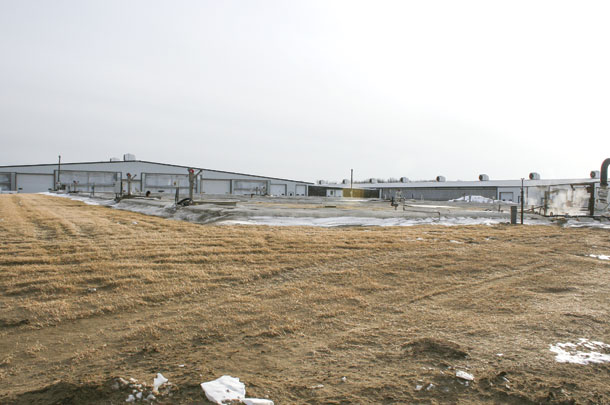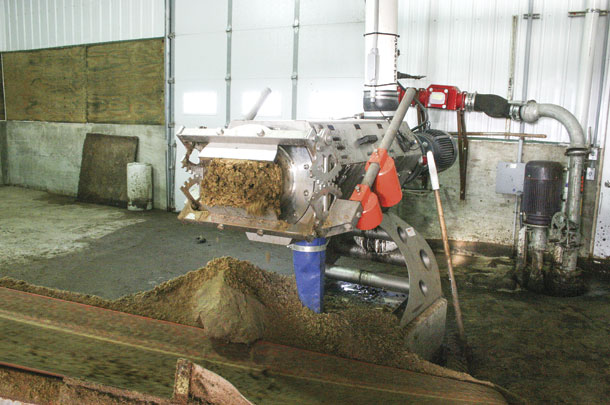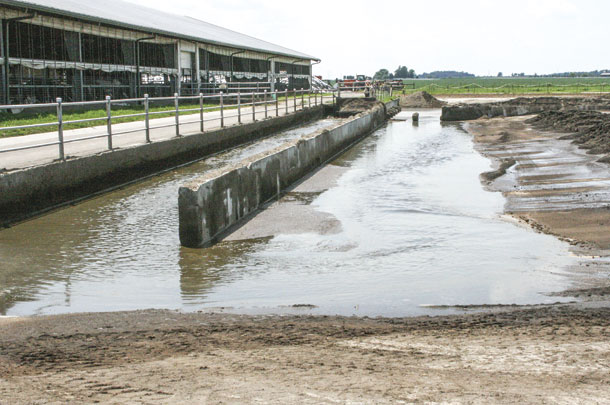“You need to think about all of these systems that go in; what is the real driver for payback?” Rebecca Larson asked at the Midwest Manure Summit Feb. 27 in Green Bay, Wisconsin.
Larson, an assistant professor in the biological systems engineering department at the University of Wisconsin – Madison, discussed how to approach this topic and outlined what four common manure systems have to offer.
When setting manure-handling goals, Larson said producers should be specific, identify the objective and consider what would happen if there was no change to the current system. Also think about how the method of collection, transport, processing, bedding type and byproducts may be affected by the changes you are considering.
Next, collect as much data as possible for manure handling on the operation. This should include annual manure production and other inputs to the manure stream; hauling periods and volumes; cost of labor, equipment, energy and maintenance; manure characteristics; hauling distances; and nutrient management plans and purchases. Make a diagram of the manure system to see where any new component would fit.
Think about manure storage facilities and if they would need to expand or change to match anticipated needs. Will byproducts such as runoff, milking system wastewater and spoiled feed be incorporated or handled separately?
Once manure-handling goals are outlined, and information on the current system has been collected, it is time to consider which technology will best fit the farm’s desires. Here is a look at four different types of manure processing systems.
1. Composting
Composting is not ideal in a system with a lot of liquid manure, but if there are multiple streams or a separator in place, it could be a good solution to add.
“You can get a huge reduction in volume, and that is a really good benefit of composting,” Larson said.
By hauling less volume (approximately 40 percent), those cost savings can be factored into the payback of the investment.
Composting also results in a product that could be sold. “We’ve seen a lot of people selling compost, but there’s a lot of requirements that are involved in building your market,” she said.
The composting process is also a way to reduce pathogens, deactivate weed seeds and degrade antibiotics if there are concerns about those in the fields.
There are different methods of composting to consider. “You can’t just say, ‘I’m going to evaluate compost’ and use numbers pretending these are the same things – they aren’t,” Larson said.
Windrows require more land base than an in-vessel system. It can be less or more labor, depending how you choose to aerate the piles. In-vessel requires less space with a shorter time frame to achieve composting, but it is likely to cost more at the start. The in-vessel will have better consistency year-round compared to windrows exposed to the elements. More space may be needed in a windrow system when composting isn’t as active in colder temperature. Another option is to use a hoop-house or covered building for compost lanes or windrows to improve consistency and reduce weather challenges.
Someone looking to sell compost may consider spending more for a consistent product whereas it may not be as important for someone looking to spread it on their farm.
Selling compost may demand a system that can be documented or an added bagging system. These require more investment but could lead to greater payback if there is an available market for it.
Another thing to consider is if the existing manure has the right carbon-to-nitrogen ratio or if a lot of high-carbon materials will need to be purchased. If purchasing, is there a source, and what will that cost?
“If your goal might be volume reduction or pathogen kill, the practices you integrate and how you control it are critical,” Larson said.
For pathogen reduction, temperature requirements need to be met. For volume reduction, you may need to take on more carbon or have more land base to hold it longer.
“I can’t express enough if you have a goal to understand what you need in meeting it,” she said.
2. Anaerobic digesters

There are a lot of digester types available to handle liquid manure or dry manure. These systems can be complete mix, plug-flow, modified plug-flow or a covered lagoon.
There’s a big movement in some areas of the country to increase the collection and treatment of food waste through a digester, which can result in profits from tipping fees.
Covered lagoons work well to reduce methane in warmer temperatures. In California, there is funding to reduce methane, so that might be the driving factor to install a covered lagoon with a low operating cost. It may also provide enough income that a generator isn’t necessary and burning it may suffice.
In some areas, price points for producing electricity can be lower than the operating cost, so that may not be a good driver unless you can obtain a high enough contract.
Another option is to clean and compress the gas for a liquefied biomethane or renewable natural gas that can be used in transportation vehicles or sold.
Carbon credits are another source of income to consider with anaerobic digesters.
“You’ve got to understand the risks that come along with some of these things too,” Larson cautioned. For instance, she questioned, “How long are those credits going to be there?”
Digesters do well at reducing pathogens when the system is operated with that in mind.
“There are different reasons that you operate something, and you can change it. As engineers, it’s very easy to do that, but if you don’t know your driver, then you don’t know to operate your system that way,” Larson said.
Other drivers for people installing digesters are to reduce odor and to improve public relations. This is a more expensive system to achieve those goals compared to other methods like composting.
Digesters are a way to implement antibiotic degradation, but composting has been shown to be more effective as some of the compounds can re-form after digestion.
“Both [digestion and composting] are comparable, but if you see some future stuff coming along that one handles better than the other; well, that might be the one you want to pick,” Larson said.
Digested manure has a much higher amount of available nitrogen, but it can be easily squandered if producers don’t implement new hauling practices to minimize ammonia losses.
For the most part, the economics of digesters are better on a large scale. When looking at these projects, get bids, consider all options, find out the level of guaranteed production and talk with someone else who has put the system in. For operating costs, Larson said she’s seen digesters on 10,000-animal-unit farms at less than $500,000 and over $1 million. “This is a huge difference. This will change the outcome of your project,” she said. “So you better understand these numbers a little bit more when you are going into this system, and particularly how scale is going to impact that.”
3. Solid-liquid separation

These are the most popular in terms of number of systems installed today. There are a lot of different types from membrane systems to rollers to centrifuges to screw presses.
It is important to look at the efficiency of each type. Recent research in Europe looked at two ways to think of efficiency of separation: how clean the liquid gets and how much is separated into the solid.
If your goal is to move a bunch of phosphorus into the solid because you need to haul it farther, that’s where the payback is, and you should focus on how much is separated into the solid portion.
“Companies should be able to provide you these [performance] numbers. If they can’t, that would be a big concern to me,” she said.
The costs vary by system and by the size of the equipment. Be sure to factor in the cost of the building and any other infrastructure changes.
The payback for a separation system typically comes from reduced hauling. A nutrient management plan and field maps are needed to calculate if those savings will pay for the technology.
Other paybacks could come from reduced maintenance, selling products and as a replacement for bedding.
Knowing the driver is necessary to know how efficient the system needs to be. A high-efficiency system may be necessary to move more phosphorus, while a low-efficiency system could work to remove just enough solids for irrigation.
Fibrous inputs, such as dairy manure, generally land in a low-efficiency system. In a study on separator efficiency in Wisconsin, Larson reported all of the systems were low-efficiency, including the centrifuge, but there was a screw press that came close to the high-efficiency mark.
“Low-efficiency isn’t terrible. It’s cheaper. It might be what you need,” she said.
In solid-liquid separation, the nutrients fractionate, and that difference will need to be accounted for in the cropping system. In low-efficiency systems, most nitrogen stays in the liquid. A high-efficiency system can move a decent amount of it into the solid.
Separating the manure does result in most pathogens remaining in the liquid, but a reduced concentration can still be present in the solids. The pathogens are not inactivated but, by separating them, the high-liquid portion can be applied in a manner that reduces risk.
4. Sand separation

Sand separation can have value when the payback is at cost because of sand’s difficulty to manage in manure.
When considering sand separation systems, think about how much space you have for separation and storage. Do you want a passive system or a mechanical system? What is your preference for sand particle size? Do you need a cyclone to remove small sand? Will you need to shake off extra liquid?
If you choose to put in a system, Larson said to make sure it is working the way it was intended. Take samples, analyze and figure out how to improve its performance.
Some of these systems can accomplish the same task, while others are unique in what they do.
“Never do I see anybody that just has one goal,” Larson said. “Most of you have a lot of goals you are trying to look at and balance at one time.”
Begin by tracking data and understanding your current system. Then figure out what you want to achieve.
“Do not pick out a technology and then try to force it to get what you want,” she said. “I also want you to understand how it will affect your facility.
“Know your data, and improve your performance by analyzing it once you get it in there. Just because it functions doesn’t mean it is functioning the way you want,” she continued. ![]()
PHOTO 1: Composting is a way to reduce manure volume and pathogens. It works best with solid manure.
PHOTO 2: Anaerobic digesters fit best on a large scale. There are many options for type and how to utilize the captured methane.
PHOTO 3: Solid-liquid separation is a way to save on hauling costs. They can be measured by efficiency, but most often dairy manure will have a low efficiency rating.
PHOTO 4: Sand separation systems can be beneficial even when returns are at cost. They can be passive (shown here), mechanical or a combination of both. Photos by Karen Lee.

-
Karen Lee
- Editor
- Progressive Dairyman
- Email Karen Lee

.jpg?t=1687979285&width=640)




